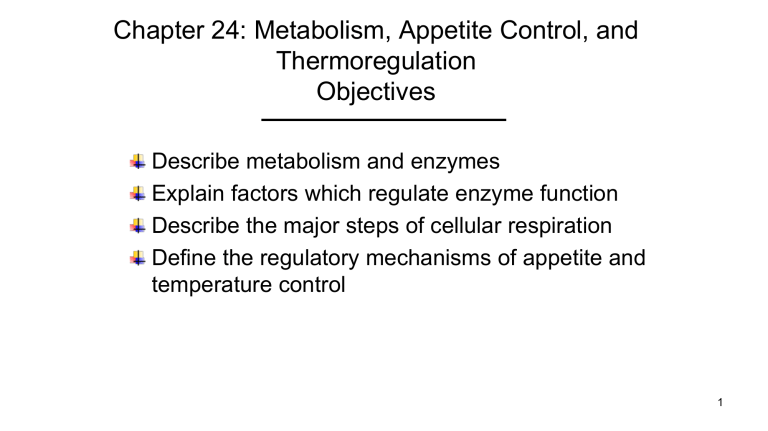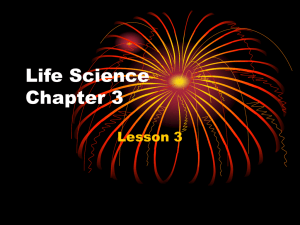
Chapter 24: Metabolism, Appetite Control, and Thermoregulation Objectives Describe metabolism and enzymes Explain factors which regulate enzyme function Describe the major steps of cellular respiration Define the regulatory mechanisms of appetite and temperature control 1 Metabolism Metabolism Anabolism Glycogenesis Protein Synthesis Transcription Translation Lipogenesis DNA Synthesis Mitosis Meiosis Catabolism Glycogenolysis Glycolysis Proteolysis Lipolysis Interconversion Gluconeogenesis Liponeogenesis Enzymes 2 Enzymes Activation energy Heat as activation energy Heat increases kinetic energy of molecules Critical thinking: Why is heat not a suitable form of activation energy in living systems? Enzymes Biological catalysts Speed up chemical reactions by lowering the activation energy 3 Enzymes: Structure Enzymes Proteins End in –ase Sucrase Substrate Active site Allosteric site Specificity 4 Mechanism of Enzyme Action 5 Cofactors and Coenzymes Holoenzyme Apoenzyme Non protein portion Non protein portion Cofactors Ex. Calcium ions Coenzymes Ex. Vitamin K 6 Environmental Effects on Enzymes Enzyme Activity Turnover rate=rate at which an enzyme catalyzes a chemical reaction Temperature pH Regulators 7 Temperature and pH Temperature Optimal Temperature Human body= Denature Enzymes pH Optima pH Human body= Denature Enzymes Exceptions Pepsin 8 Regulators Promoters Hemoglobin Inhibitors Competitive Inhibitors Active site Noncompetitive Inhibitors Allosteric site Antibiotics 9 Stop and Practice Statement Answer Define the general function of enzymes Differentiate between active and allosteric site on an enzyme Define general function of cofactors and coenzymes Enzyme which loses its structure is said to be Inhibitors which bind to allosteric site 10 10 Cellular Respiration Cellular Respiration Anaerobic Aerobic Critical thinking: Why do cells need energy? Skeletal muscle cells Cardiac muscle cells Nerve cells Critical thinking: Why do we need to convert glucose into ATP? 11 Mitochondrion Mitochondrion Outer membrane Inner membrane Cristae Proteins Matrix Enzymes mDNA 12 Aerobic Respiration: Steps Cellular Respiration Reactants Glucose Oxygen Products Water Carbon Dioxide 34 ATP-Energy Currency Basic Steps Glycolysis Citric acid cycle Electron-transport system 13 Glycolysis Glycolysis Location: Cytosol Reactants: Glucose (1) ATP (2) Products: Pyruvate (2) NADH (2) ATP (4) 14 Citric Acid Cycle Citric Acid Cycle Location: Mitochondrial Matrix Reactants: Acetyl-CoA (modified pyruvate) Products: FADH2 (1) NADH (4) ATP (1) CO2 (3) 15 Electron-transport System Electron-transport system Location: Mitochondrial cristae Cytochrome enzymes Proton pump ATP synthase In: 1 NADH FADH2 O2 (Final Electron Acceptor) (6) Out: ATP (30) H2O (4) 16 2 3 Anaerobic Respiration Anaerobic Respiration Location: Cytoplasm Pyruvate (Final electron acceptor) Alcohol Fermentation Pyruvate converted to Ethanol Lactic Acid Fermentation Pyruvate converted into lactic acid Skeletal Muscle During exercise? During common cold? 17 Stop and Practice Statement Answer Starting materials and end products of cellular respiration include Glycolysis yields a net of how many ATPs CO2 is generated during this step of cellular respiration Cellular respiration which takes place in absence of oxygen 18 18 Regulation of Appetite Short Term Regulation Ghrelin PYY Insulin Long Term Regulation Leptin Thyroid hormone Cortisol Lipotropins 19 States of Energy Potential energy Chemical energy Kinetic energy Electrical energy Mechanical energy Sound energy Radiant energy Heat 20 Laws of Thermodynamics Laws of Thermodynamics First law of thermodynamics Second law of thermodynamics 21 Thermoregulation Thermoregulation Maintenance of body core temperature close to 37 ºC. Critical thinking: Why is it important to maintain temperature at 37 degrees C? Hypothalamus Thermoregulatory centers Peripheral thermoreceptors Central thermoreceptors 22 Thermoregulation: Heat Exchange Heat exchange Heat always flows from an area of higher temperature to an area of lower temperature until the two areas achieve an equilibrium with respect to temperature. Conduction Convection Radiation Evaporation 23 High Environmental Temperature Increase in body temperature Maximize heat loss Vasodilation of cutaneous blood vessels Increased sweating Behavioral responses Use of fans Immersion in cool water Staying out of sun Minimize heat production Diminish food intake Behavioral responses Decreased physical activity Decrease in contraction of skeletal muscles 24 Low Environmental Temperature Decrease in body temperature Minimize heat loss Vasoconstriction of cutaneous blood vessels Contraction of arrector pili muscle Behavioral responses Adding layers of clothing Curling up Standing near heat source Maximize heat production Shivering thermogenesis Contraction of skeletal muscles Nonshivering thermogenesis Mitochondrial uncoupling in adipocytes of brown fat Behavioral responses Increased voluntary activity Increased contraction of skeletal muscles 25 Stop and Practice Statement Answer Hormone which stimulates appetite centers Hormone produce by adipose tissue Define the term conduction Receptors which detect external temperature Define shivering thermogenesis 26 26



